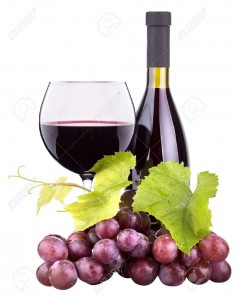 Day-colored wine,
Day-colored wine,
night-colored wine,
wine with purple feet
or wine with topaz blood,
wine, starry child of earth,
wine, smooth as a golden sword,
soft as lascivious velvet,
wine, spiral-seashelled and full of wonder,
amorous, marine;
never has one goblet contained you,
one song, one man,
you are choral, gregarious,
at the least, you must be shared. ~ Pablo Naruda
Valentine’s Day in the Philippines is never going to be an understated affair. In the land of endless occasions, events and celebrations, Valentine’s day is always going to be a Big Deal – after all, it’s more fun in the Philippines – and the malls abound with flowers, cards, chocolates, ribbon, L.O.V.E…
But before we go shopping for love hearts and poetic verses, a little research. Hallmark may think it invented Valentine’s Day in the last century, but in fact, it has been celebrated for much longer than that, and legends and folklore abound. First,  some say, there was Lupercalia, the pagan festival of fertility that was celebrated in mid-February, and some will state that our modern St Valentine’s Day was a Christian attempt to claim/clean up/Christianize a dubious pagan festival, by creating a feast day honoring one or more early – often martyred – catholic Saint Valentines. This tradition was refined in the 14th century, when courtly love flourished, and Chaucer wrote a poem ‘A Parlement of Foules’ that claimed Valentine’s Day for lovers. Romantic Victorians added fuel to the flames with the notion of giving gifts of flowers, confectionary and cards to The Beloved.
some say, there was Lupercalia, the pagan festival of fertility that was celebrated in mid-February, and some will state that our modern St Valentine’s Day was a Christian attempt to claim/clean up/Christianize a dubious pagan festival, by creating a feast day honoring one or more early – often martyred – catholic Saint Valentines. This tradition was refined in the 14th century, when courtly love flourished, and Chaucer wrote a poem ‘A Parlement of Foules’ that claimed Valentine’s Day for lovers. Romantic Victorians added fuel to the flames with the notion of giving gifts of flowers, confectionary and cards to The Beloved.
No such gifts here, but in true Bacchanalian style we celebrated with the noble grape, and a wine workshop for lovers in Ortigas. The Study is an imaginative little space on Level 4 at the Podium, where Enderun Colleges has recently set up a satellite school for languages, short courses and workshops. To be honest, we have never really availed of Valentine’s Day. The One & Only doesn’t like to be told when to buy me flowers, apparently and I concur that I prefer spontaneity over prescribed bursts of affection. This year, however, after receiving an invitation to a Valentine’s Day wine tasting, we decided to make an exception.
Eight couples gathered together with our guide, Enderun’s Assistant Dean for the College of Hospitality Management, Bel Castro, who provided an hour’s seminar on the vocabulary of wine tasting followed by a tasting workshop. I remember my first wine tasting class back in the Middle Ages (the 1980s) when I was given my first tasting wheel. I was riveted. Amusingly this wheel probably wouldn’t work too well in the Philippines because there are too many flavours unfamiliar to Filipino taste buds. Grapes are not grown in the tropics, so most of the taste comparisons are to fruit grown in more temperate climes. And who, here, would know a gooseberry or a plum?
vocabulary of wine tasting followed by a tasting workshop. I remember my first wine tasting class back in the Middle Ages (the 1980s) when I was given my first tasting wheel. I was riveted. Amusingly this wheel probably wouldn’t work too well in the Philippines because there are too many flavours unfamiliar to Filipino taste buds. Grapes are not grown in the tropics, so most of the taste comparisons are to fruit grown in more temperate climes. And who, here, would know a gooseberry or a plum?
So, with hundreds of wines to choose from, and only three hours to cover it all, Bel wisely decided to introduce us to only seven major wine styles: Chardonnay, Riesling and Sauvignon Blanc, Pinot Noir and Merlot, Cabernet Sauvignon and Shiraz. For each she listed the most common aromas and flavours to recognize, and then provided the relevant fruits for us to try, such as apples, (both green and red), asparagus, beans, cucumber, plum and dried apricot. This way, we were all prepared with a memory of certain tastes and smells, when swirling our first wines.
Our group was an interesting mix: some were first timers at wine tasting, others had tasted plenty, but claimed they knew little about what they were actually drinking. A few, like us, thought we knew plenty. Bel proved we still had a lot to learn. Wines were mostly New World wines from New Zealand, Australia and South Africa, with one rather nice Bordeaux dessert wine putting in an appearance to great acclaim.
With the first three glasses of wine sitting before us, Bel taught us how to taste with the tips of our tongues for sugar, and with the salivary glands at the back of our mouths for acidity. Then we began to work on our ability to pick the flavours we had discussed previously: could we taste the typical green apples, lemon and herbaceousness in a glass of Sauvignon Blanc from Marlborough, New Zealand? Did we notice the fresh pineapple and gooseberries of the Chardonnay from Hawkes Bay, with its touch of buttermilk? And was it really car oil and tennis balls in the glass of the Riesling from the Clare Valley?
and with the salivary glands at the back of our mouths for acidity. Then we began to work on our ability to pick the flavours we had discussed previously: could we taste the typical green apples, lemon and herbaceousness in a glass of Sauvignon Blanc from Marlborough, New Zealand? Did we notice the fresh pineapple and gooseberries of the Chardonnay from Hawkes Bay, with its touch of buttermilk? And was it really car oil and tennis balls in the glass of the Riesling from the Clare Valley?
We compared the barely-there colour of the Sauvignon Blanc to the pale honey colour of the lightly oaked Chardonnay and the in-between, palest yellow of the Riesling. And then we started to experiment with wine and food matches. What went best with the smoked salmon, and why? Why did the Chardonnay and the blue cheese pair up so happily? Didn’t the Sauvignon Blanc make a good palate cleanser, with its short, snappy, zesty flavor?
Then we threw in a late harvest Riesling from the Riverina winemakers at Beelgara estate. (NB: late picked, therefore greater natural sugar development, therefore sweeter wine. In theory.) It didn’t do so well with the smoked salmon, but I could imagine it pairing up beautifully with some creamy salmon sashimi.
Arriving a little prematurely for a standard food menu, Bel nonetheless nudged us towards a deep yellow Bordeaux Sauternes, as it was a good chance to compare relative sweetness. Sauternes is often made from Sauvignon Blanc grapes that have been affected by botrytis cinerea – a fungus known more enticingly as noble rot that enormously increases sugar content in affected grapes and creates highly concentrated dessert wines. It was therefore particularly interesting to taste the difference between this and the young, unaffected, highly acidic Sauvignon Blanc table wine. We threw a lot of lovely descriptors around the table for this one: musty, damp wool, raisins on the vine, lolly water, apricot conserve, oily orange zest, marmalade. With a small caramel cookie to accompany it, it was easy to see how such a wine would pair happily with a wide range of desserts.
Feeling more confident, we then launched into the reds and pinks. Beginning with a South African rosé, aptly named Lazy Days, we observed red apples, lemon curd and cranberry – a comfortable, summer-afternoon half way mark between the zingier whites and the fruitier reds, that we all felt would be perfect with shellfish.
Then we played around with some deeper red wines. Pinot Noir is a cool climate wine associated with the Burgundy region of France, that has done particularly well in New Zealand. This particular Pinot came from Marlborough, on the north eastern tip of the South Island. Bel pointed out that it is a medium intensity red: that is, translucent enough to read our notes through the wine. As the Sauvignon Blanc of red wines, it also has a short memory on the tongue, its colour more reminiscent of red fruit than the purple-blackness of Shiraz or Cabernet Sauvignon. And it is definitely a drink-me-now wine, rather than one to cellar and revisit later.
 Our last two examples were both intense, full-bodied South Australian reds, from McLaren Vale, brimming with tannin and fruit, and heavy doses of hot sunshine. McLaren Vale has a Mediterranean climate of warm, dry summers, mild winters and sea breezes. Cabernet Sauvignon and Shiraz grapes thrive here. The One & Only has long been a fan of Cabernet Sauvignon, whereas I have previously tipped in favour of Shiraz, but I swapped allegiances today, much preferring the Pirramimma 2011 Stocks Hill Cabernet Sauvignon to the Mitolo Wines 2011 Jester Shiraz. The Pirramimma Winery was founded in 1892 and is still in the hands of the original family. Its, lovely, lilting name is an Aboriginal phrase meaning “the moon and the stars.” In contrast, Mitolo’s is a relative newcomer, the brain child of Frank Mitolo, a grandson of Italian migrants with a long heritage of farming and wine making, who only made his first wine in 2000. It is a hearty Shiraz, a good one to drink immediately with an equally hearty steak, but today I preferred the surprisingly fruity, but earthier tones of the Cabernet, with its spicy finish.
Our last two examples were both intense, full-bodied South Australian reds, from McLaren Vale, brimming with tannin and fruit, and heavy doses of hot sunshine. McLaren Vale has a Mediterranean climate of warm, dry summers, mild winters and sea breezes. Cabernet Sauvignon and Shiraz grapes thrive here. The One & Only has long been a fan of Cabernet Sauvignon, whereas I have previously tipped in favour of Shiraz, but I swapped allegiances today, much preferring the Pirramimma 2011 Stocks Hill Cabernet Sauvignon to the Mitolo Wines 2011 Jester Shiraz. The Pirramimma Winery was founded in 1892 and is still in the hands of the original family. Its, lovely, lilting name is an Aboriginal phrase meaning “the moon and the stars.” In contrast, Mitolo’s is a relative newcomer, the brain child of Frank Mitolo, a grandson of Italian migrants with a long heritage of farming and wine making, who only made his first wine in 2000. It is a hearty Shiraz, a good one to drink immediately with an equally hearty steak, but today I preferred the surprisingly fruity, but earthier tones of the Cabernet, with its spicy finish.
We compared notes on acidity and tannin, mineral tones and oakiness. We discussed which went better with the meek-and-mild salami, which with the hot, peppery one. We contemplated which wine we preferred with dark chocolate. We emptied our glasses and poured some more. At the end of this friendly, funny, informative session, we were each awarded a certificate of attendance and a pretty heart-shaped lollypop. A thoroughly satisfactory way to celebrate St. Valentine’s Day. He would have been proud.
*With heart-shaped thanks to my One & Only for his photos, and also to Google Images for theirs.
